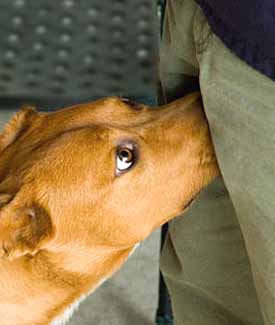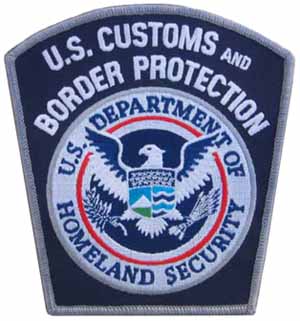Buster
Miscues By Narcotics Detection Canines Mar Recent Federal Stop-And-Sniff Operations
Last Thursday evening, Rodney McDade sought to reenter the U.S. from Mexico via a pedestrian lane at the Calexico port of entry in southern California.
The 52-year-old McDade, who declared that he was not carrying anything into his home country, was directed to a "secondary inspection  area" after a U.S. Customs and Border Protection agent determined that he had an extensive criminal record (including busts for drug possession).
area" after a U.S. Customs and Border Protection agent determined that he had an extensive criminal record (including busts for drug possession).
At the secondary office, a CBP officer conducted a pat-down search of McDade, which "resulted in negative results," according to a court filing. But agents were not done with him.
McDade was then brought to a third office, where he declined to undergo "a more thorough inspection by CBP officers." Such thoroughness would have included McDade disrobing so that federal agents could take a, um, closer look for contraband.
Denied the opportunity for a strip search, a CBP officer then screened McDade with a "Human/Narcotic Detector Dog." Since the animal began working in the field in 2010, it had "never had any false ‘hits,'" investigators reported.
When the unnamed dog took a whiff, it "alerted to buttocks area of McDade."
That's when federal agents drafted a search warrant noting that there was "probable cause to believe that McDade’s anal crevice may contain evidence, fruits, and instrumentalities" of violations of several laws.
Four hours after McDade sought to cross into California, a federal magistrate signed an 11:15 PM warrant allowing agents to first X-ray McDade to search for "any contraband within his anal cavity." If the X-ray proved positive or inconclusive, the agents were authorized to have a medical professional conduct a "cavity examination."
Warrant in hand, agents transported McDade to Pioneers Memorial Hospital, where his rectal area was X-rayed. A positive result would have  surely resulted in a narcotics trafficking charge carrying a stiff prison sentence.
surely resulted in a narcotics trafficking charge carrying a stiff prison sentence.
However, as detailed in a search warrant inventory, the examination of McDade resulted in "negative X-ray results." While the detector dog "alerted" to McDade’s buttocks, no foreign substances were stashed in his anal crevice. Which spared him a follow-up cavity search.
McDade was released from custody at 2 AM. Without an apology from the law enforcement asset that earlier had been sniffing his buttocks.
Another narcotics detection canine used by federal agents also recently had some miscues during a drug interdiction operation run by Drug Enforcement Administration agents and postal inspectors, according to a U.S. District Court filing.
The dog, "Lilly," last month screened 30 packages at a U.S. Mail facility in Washington state. The canine alerted to 16 packages, eight of which were subsequently opened by agents expecting to find drugs and other contraband.
Instead, one package contained "dental work," while others held photographs and perfume. Two packages had marijuana, one had cash, and the other two contained "illegal passports." Prior to these incorrect alerts, "Lilly" had a 94 percent accuracy rate, reported investigators, who added that the dog is rewarded with "her tennis ball" upon completion of searches.

